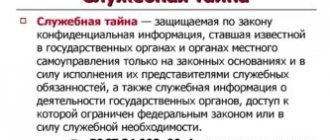Why does a company need a trade secret clause?
This situation is interesting for most modern companies, because one of the most important competitive advantages in business is the company’s possession of various types of confidential data of the widest range.
First of all, data on the company’s own developments that determine the competitiveness of the products or services provided will be confidential. The company may have valuable information about competitors and insider information. It is also logical to classify them as trade secrets.
It should be noted that clause 5 of the Law “On Trade Secrets” dated July 29, 2004 No. 98-FZ specifies a list of information that should not constitute a secret.
This includes information:
- about the company, recorded in its constituent documents;
- documents giving the right to carry out entrepreneurial activities;
- property of the organization, if it is a unitary enterprise or government agency;
- the impact of the company’s production activities on the environment and the safety of citizens;
- number of personnel, specifics of remuneration in the organization, labor protection, vacancies;
- employer's debts to employees;
- violations of the legislation of the Russian Federation by the company and its employees and holding them accountable for them;
- participation of the company in privatization on a competitive or auction basis;
- the amount and structure of income and expenses, property, use of volunteer labor, if the company is an NPO;
- persons who have the right to work on behalf of the company without a power of attorney;
- other information that cannot be classified as a trade secret by force of law.
The regulation on trade secrets is a normative act that establishes the composition of the duties of employees regarding its non-disclosure, as well as defining the mechanisms of liability of employees for failure to fulfill these duties.
If the employing company suffers losses associated with the failure of certain employees to fulfill their obligations to maintain trade secrets, it will have the right to recover them from the violators, but only on the condition that they have signed the corresponding provision.
You can find out more about liability for disclosure of trade secrets in ConsultantPlus:
Trial access to the legal system is free.
Regulations on trade secrets
Regulations on trade secrets
General provisions
1.1.
This Regulation has been developed in accordance with the Civil Code of the Russian Federation, Federal Law dated July 29, 2004 N 98-FZ “On Trade Secrets”, Decree of the President of the Russian Federation dated March 6, 1997 N 188 “On approval of the list of confidential information” and other regulations and establishes security regime for information created, acquired or accumulated in the course of the activities of Phoenix LLC (hereinafter referred to as the Company), located on paper, magnetic and other types of media and constituting a trade secret (confidential information) of the Company. 1.2. The security regime for information constituting a trade secret provides for:
— the procedure for classifying information as a commercial secret of the Company;
— organizing access to information constituting a trade secret;
— the procedure for handling documents containing information constituting a trade secret;
— responsibilities of the Company’s employees who have access to information constituting a commercial secret;
— means and methods of technical protection of information constituting a trade secret, and other measures that do not contradict the legislation of the Russian Federation;
— responsibility for disclosure of information constituting a trade secret.
1.3. Responsibility for ensuring the security regime for information constituting a trade secret in the structural divisions of the Company rests with their managers.
1.4. The procedure for ensuring the protection of information constituting a trade secret in the Company’s information systems, as well as other means and methods of technical protection of such information, are determined by separate regulatory documents of the Company.
Basic terms and definitions
2.1. Trade secret is information that has actual or potential commercial value due to its unknownness to third parties, there is no free access to it on a legal basis, and the Company takes measures to protect its confidentiality.
2.2. Access to a trade secret is the familiarization of certain persons with information constituting a trade secret, with the consent of its owner or on another legal basis, subject to maintaining the confidentiality of this information.
2.3. Transfer of a trade secret is the provision of information constituting a trade secret of the Company and recorded on tangible media to certain persons, subject to the condition that they take measures established by law or agreement to protect the confidentiality of information.
2.4. Disclosure of a trade secret is a culpable act (action or inaction) as a result of which information constituting a trade secret of the Company becomes known to third parties without the consent of the Company, as well as contrary to an employment or civil law contract.
2.5. Document is information recorded on a tangible medium (paper, magnetic or other) with details that allow it to be identified.
The procedure for classifying information as a commercial secret of the Company
3.1. Identification and assessment of the degree of confidentiality of information constituting a trade secret is carried out by the permanent commission of the Company for the Protection of Trade Secrets (hereinafter referred to as the Commission).
3.2. The commission is formed from the heads of the Company's structural divisions.
3.3. In order to fulfill its duties, the Commission may create working groups from among the Company’s employees and involve individual Company specialists and individuals for consultations.
3.4. The decision of the commission to classify information as protected information is formalized in the form of a draft list of the main categories of information constituting a commercial secret of the Company.
3.5. The list of information constituting a trade secret of the Organization comes into force after its approval by the head of the Company. If necessary, the List may be revised by the commission at least once a year.
3.6. Information constituting a state secret, as well as information listed in Art. 5 of the Federal Law of July 29, 2004 N 98-FZ “On Trade Secrets”.
3.7. The list of information constituting a commercial secret of the Company is given in Appendix No. 1 to the Regulations.
Access to information constituting a trade secret
4.1. The procedure for registering the right of the Company's employees and persons performing temporary work in the Company on the basis of fixed-term employment and civil law contracts to access information constituting a commercial secret provides for:
— their acceptance of personal obligations regarding non-disclosure of information constituting a trade secret;
— their consent to partial, temporary restrictions on the rights to disseminate information constituting a trade secret;
— familiarizing them with the norms of the legislation of the Russian Federation, providing for liability for the disclosure of information constituting a trade secret.
4.2. The procedure for registering the right of persons to access information constituting a trade secret is carried out on a voluntary basis in accordance with Appendix No. 2 to these Regulations.
4.3. Access to information constituting a trade secret must include familiarizing the employee with the requirements for maintaining the Company's trade secrets. Employees and persons performing temporary work on the basis of fixed-term employment and civil law contracts are provided with information constituting a trade secret to the extent necessary for them to perform their official duties.
4.4. Responsibility for organizing direct access to information constituting a trade secret rests with the heads of the Company's structural divisions.
4.5. Information constituting a trade secret is provided to government bodies and their officials acting legally within the powers granted to them by law, in the manner prescribed by current legislation, and with the written permission of the head of the Company or his deputies.
Procedure for handling documents containing trade secrets
5.1. Working with documents containing confidential information is permitted only at workplaces in the Company's office premises. If necessary, work with documents containing confidential information outside of office premises may be permitted to an employee of the Company by the Deputy General Director or the head of a division of the Company.
5.2. On documents containing confidential information, “Phoenix” and copy numbers are indicated in the upper right corner of the first page of the document and the cover letter.
5.3. Documents submitted in accordance with current legislation to government agencies are not marked “Trade secret of Phoenix LLC.”
5.4. Documents marked “Trade secret of Phoenix LLC” are subject to mandatory registration by an employee of the structural unit responsible for recording documents bearing the specified mark. This employee is appointed by verbal order of the head of the relevant structural unit.
5.5. The transfer of documents marked “Trade secret of Phoenix LLC” between employees of the Company is permitted only when strictly necessary.
5.6. All documents containing information constituting a trade secret must be stored in office premises in securely locked cabinets, desk drawers or safes.
Responsibilities of employees admitted to information constituting a trade secret
6.1. Employees of the Company who have access to information constituting a commercial secret are obliged to:
— comply with the procedure for ensuring the protection of information constituting a trade secret, established by these Regulations and other regulatory documents of the Company;
— get acquainted only with those documents containing confidential information to which access was gained in accordance with the performance of official duties;
- keep confidential information known to them secret;
— transfer documents containing confidential information only to those employees of the Company who are directly related to them;
— strictly observe the procedure for handling documents containing information constituting a trade secret, and ensure the safety of the information contained in them in the course of their work;
— introduce representatives of third-party organizations to documents containing information constituting a trade secret only on the instructions of the immediate superior and in compliance with the requirements established by these Regulations;
— not to use knowledge of information constituting a trade secret to engage in any activity that may cause damage to the Company;
- inform the immediate superior about violations of the procedure for handling documents containing confidential information, about attempts of unauthorized access to them, as well as about the loss or shortage of carriers of such information;
— in case of dismissal, hand over all documents containing information constituting a trade secret to the Company officials responsible for recording documents containing the mark “Trade secret of Phoenix LLC.”
6.2. The Company's employees are prohibited from:
- use information constituting a trade secret in open correspondence, in the open press, in radio and television broadcasts, in public speeches, in public information and telecommunication networks (including the Internet), as well as in any other way disseminate information constituting a trade secret ;
— use various technical means to record and otherwise reproduce documents containing confidential information;
— unauthorized transfer to other persons of documents containing confidential information;
— use confidential information for personal interests;
— remove documents and media containing information constituting a trade secret from the Company without the permission of the immediate manager.
6.3. Termination of an employment contract, regardless of the grounds, does not relieve the employee of his obligations not to disclose information constituting a trade secret.
Responsibility for disclosure of information constituting a trade secret
7.1. Responsibility for the disclosure of information constituting a trade secret rests personally with each employee of the Company who has access to this information and allowed its disclosure. Persons who disclose the specified information are brought to disciplinary, administrative, civil, and criminal liability in the manner established by federal laws, as well as labor and civil contracts.
7.2. Upon disclosure of information constituting a commercial secret, the Company is conducting an internal investigation. The period for conducting the investigation is no more than one month from the date of discovery of the fact of disclosure of information.
7.3. If there are signs of an administrative offense or crime in the actions of a person who has disclosed information constituting a trade secret, the Company's management has the right to contact law enforcement agencies to bring him to justice in accordance with current legislation. If the actions of a person who disclosed information constituting a trade secret caused material harm, and if the Company’s management refuses to voluntarily compensate for it, it has the right to go to court to protect its interests.
7.4. If a violation of the procedure for handling documents is detected, which did not lead to the disclosure of information constituting a trade secret, disciplinary measures may be taken against the person who committed the violation.
Source - “Human Resources Department of a Commercial Organization”, 2014, No. 1
Trade Secrets Regulations 2020: Sample Structure
The legislator does not define or even recommend the structure of this normative act. Based on the practice of management in Russian companies, it can be assumed that the regulations on trade secrets, a sample of 2020 will be presented below, have the following main sections, which establish:
- general provisions;
- the essence of the concepts used in the document;
- powers of the company's management in terms of ensuring the safety of trade secrets;
- list of information constituting a trade secret:
- the procedure for classifying this or that information as a trade secret;
- a list of responsibilities of employees to ensure the safety of trade secrets;
- the procedure for access of certain persons to trade secrets;
- mechanisms for protecting trade secrets operating at the enterprise;
- mechanisms for employee liability for violation of obligations provided for by the regulations.
The document can be supplemented with various applications. They may include:
- detailed lists of information that constitute a trade secret;
- personalized obligations of employees to ensure the safety of trade secrets.
At the same time, information constituting a trade secret can be classified into categories based on the established procedure for their use in specific structural divisions of the company. Heads of internal corporate departments must familiarize themselves with these applications against signature.
Employees of the company must also confirm by signing the fact that they have read the list of personal responsibilities for protecting trade secrets given in the appendix to the regulations.
The provision on trade secrets is certified by the head of the company. In many organizations it is also customary to coordinate it with a lawyer.
Regulations on commercial secrets of an enterprise: basic information
The Regulation on Trade Secrets (hereinafter referred to as the Regulations) is a local regulatory act of the organization and serves to regulate relations related to the emergence, change and termination of the trade secret regime (hereinafter referred to as CT).
Thus, the main goal of the Regulations is to ensure the safety of the data that makes up the enterprise’s CT. The regulation is not a mandatory document and is drawn up depending on the needs of the legal entity. When drawing up the Regulations, one should rely on the norms of the current legislation and the statutory documents of the organization.
The following should be used as a regulatory framework:
- Law “On Trade Secrets” dated July 29, 2004 No. 98-FZ;
- Law “On Information, Information Technologies and Information Protection” dated July 27, 2006 No. 149-FZ;
- Resolution of the Government of the RSFSR “On the list of information that cannot constitute a commercial secret” dated December 5, 1991 No. 35 (hereinafter referred to as Resolution No. 35);
- Labor Code of the Russian Federation, etc.
The employer, against receipt, must familiarize his employee with the list of information that forms the organization’s CT, as well as the rules for working with such information and penalties for non-compliance (Clause 1, Article 11 of the Law “On Trade Secrets”). For information on drawing up a separate obligation, read the article Obligation of non-disclosure of trade secrets.
Categories of employees who have access to confidential data necessary for them to perform their job duties must be familiar with the Regulations.
Results
The management of an enterprise can establish the procedure for ensuring the protection of trade secrets at the local level by developing and approving a special regulation. It is supplemented by various applications that regulate in more detail the tasks of employees of the company or its structural divisions in terms of maintaining trade secrets.
You can familiarize yourself with the specifics of other provisions applied at Russian enterprises in the articles:
- “Regulations on the occupational safety and health management system - sample”;
- “Regulations on remuneration of employees - sample 2019-2020.”
Sources: Law “On Trade Secrets” dated July 29, 2004 No. 98-FZ
You can find more complete information on the topic in ConsultantPlus. Full and free access to the system for 2 days.









